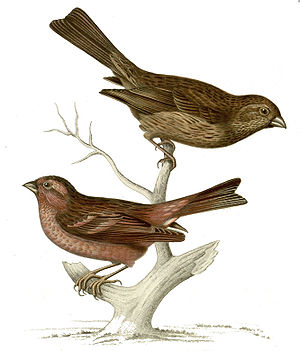Bullfinches
| Bullfinches | ||||||||||||
|---|---|---|---|---|---|---|---|---|---|---|---|---|

African bullfinch ( Carpodacus pulcherrimus ) |
||||||||||||
| Systematics | ||||||||||||
|
||||||||||||
| Scientific name | ||||||||||||
| Carpodacus pulcherrimus | ||||||||||||
| ( Moore , 1856) |
The bullfinch ( Carpodacus pulcherrimus ) is a songbird from the finch family . It occurs from the Himalayas to central and northern China.
description
Appearance
The bullfinch is 15 cm long and about the same size as a chaffinch . It is a medium-sized Karmingimpel -Art that both the smaller Aurora Gimpel and the Rose brewing Gimpel is very similar. Especially the females of these three species can hardly be distinguished in the field. The males differ in the color of the pink areas, the males of the latter species are brown on top and often less strongly striped.
The wing length is 74–81 mm in the male and 74–78 mm in the female. The tail length is between 62 and 64 mm. The beak is dark brown above and pale brown below. The feet are flesh-colored to pale brown.
The sexes differ significantly in the color of the plumage. In the male, the forehead is dark pink and ends in a wide stripe over the eyes in a light lilac pink. The over-eye stripe extends to the sides of the neck, where it fades. The pink color changes with the incidence of light and can sometimes appear almost colorless gray. The reins, chin and cheeks are also dark pink, on the cheeks and chest this turns into lighter pink. This often extends to the upper abdomen. Depending on the subspecies, the dark pink of the throat also extends over the whole breast. The sides are sometimes darkly dashed. The lower abdomen is whitish, the under tail-coverts and rear sides of the abdomen pale pink. Eye stripes, ear covers and part of the sides of the neck are gray-brown and tinged with pink. The crown, neck, sides of the neck and a part of the flanks that is often clearly set off towards the belly are gray-brown with dark dashed lines. This is much coarser on the also gray back and shoulders and looks almost diamond-like due to the dark feathers. The rump is solid pink, the upper tail-coverts brown with darker feather centers and pink edges. The arm covers are matt or dark brown with warm brown hems and pink tips. Fittich, coverts and wings have pale brown edges, which show wider beige on the arm wings. The forked tail is dark brown with warm brown feather edges.
The female looks much more inconspicuous gray-brown. The top is gray-brown with dark stripes. The stripe above the eyes is beige, the rump is a single color, pale brown. The underside, including the throat and front face, is lighter to whitish with thick and coarse dark brown stripes. The wing feathers are similar to those of the male, but without pink and with narrower hems and tips of the arm covers.
The youth dress hardly differs from that of the female. Males in the first year also resemble the females and also sing, court or breed in this dress. The adult dress is only developed in late summer and towards winter.
The species often sits motionless in the vegetation and freezes in case of danger. When excited, the head plumage is often set up in a small hood.
voice
The call is a soft, muffled trip , trilp, or trillip , a sparrow-like tchillip, and a soft, tit-like chirping or trilling. In flight, a hard shaaaannn is often given. The singing has not yet been described and may only be heard rarely.
Distribution and geographic variation
The bullfinch colonizes parts of the Himalayas as far as central and northern China. The subspecies differ in the intensity of their coloring. The largest subspecies C. p. overall waltoni is lighter and more pink underneath. The female is lighter than that of the nominate form.
- C. p. argyrophrys Berlioz , 1929 - south of Inner Mongolia , southward to southwestern Gānsù and eastern Qinghai , also from southern Sichuan to northern Yunnan
- C. p. davidianus Milne-Edwards , 1865 - southwest Inner Mongolia and Ningxia , south to Hubei , Shanxi and middle Shaanxi
- C. p. pulcherrimus (Moore, 1856) - Himalayas from Kashmir and northwestern India eastward through Nepal , parts of southern Tibet and from Sikkim to Arunachal Pradesh
- C. p. waltoni ( Sharpe , 1905) - southeastern Tibet to the extreme north of Yunnan.
The ringed bullfinch is common in the entire distribution area and the most common carfinfinch species in northern Nepal. He's not threatened.
Way of life
The bullfinch colonizes shrubs made of rhododendron , buckthorn , oak and juniper and can be found in forest edge and settlement habitats and above the tree line in individual bushes on barren slopes. In summer it lives at altitudes between 3600 and 4650 m, in Tibet also at lower altitudes. In winter it stretches into lower regions between 2100 and 3600 m.
The species lives in pairs or in smaller groups and mostly looks for food in the lower shrub layer or on the ground. The diet consists of seeds and buds.
literature
- P. Clement, A. Harris, J. Davis: Finches and Sparrows , Helm Identification Guides, London 1993/1999, ISBN 0-7136-5203-9
Web links
- Carpodacus pulcherrimus in the endangered Red List species the IUCN 2009. Posted by: BirdLife International, 2009. Accessed on March 18 of 2010.
- Videos, photos and sound recordings of Carpodacus pulcherrimus in the Internet Bird Collection
- Photos for Carpodacus pulcherrimus in the Oriental Bird Club image database , accessed on March 18, 2010